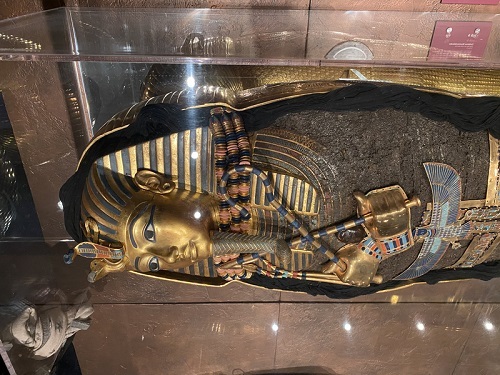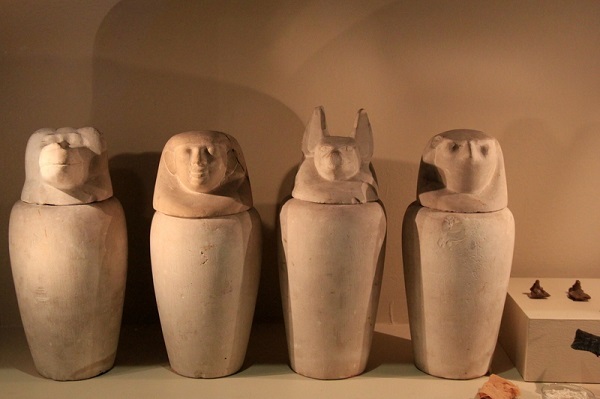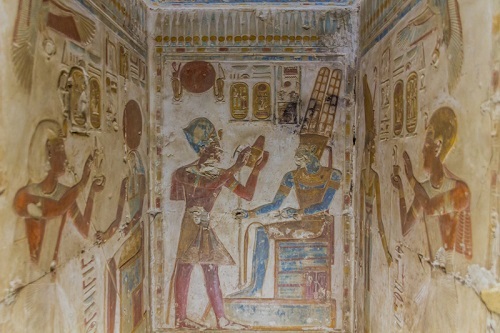

Funerary beliefs, practices, and temples in ancient Egypt were integral parts of the culture and society. The ancient Egyptians believed in an afterlife, and had elaborate funerary rituals and ceremonies to ensure the deceased's safe passage into the afterlife. Mummification was a common funerary practice, in which the deceased's body was preserved to ensure an eternal afterlife.
Temples and tombs were built to honor the gods and goddesses and to serve as the final resting place for the deceased. The funerary beliefs and practices varied among the different ancient Egyptian societies, and changed over time with the influence of different pharaohs and gods.

Gold mask and replicas from Egypt pharaoh Tutankhamun
Mummification was a common funerary practice in ancient Egypt, in which the deceased's body was preserved to ensure an eternal afterlife.
The process of mummification involved several stages, including the removal of the internal organs, the drying of the body with natron, and the wrapping of the body in linen bandages.
Special tools and equipment such as hooks, knives, and needles were used to remove the internal organs, and the body was then stuffed with sawdust, linen or resin to give it shape.
The mummification process could take up to 70 days and was performed by specialized priests known as "embalmers".
The mummies were then placed in sarcophagi or coffins, which were decorated with intricate carvings, hieroglyphics, and sometimes even bright colors.
Mummies were often placed in tombs or burial chambers, which were built to protect the mummy and funerary artifacts from grave robbers.
The ancient Egyptians believed in an afterlife, in which the deceased would be judged by the god Osiris and, if found worthy, granted eternal life.
Funerary rituals and ceremonies were an important aspect of ancient Egyptian culture, and were believed to ensure the deceased's safe passage into the afterlife.
Offerings and sacrifices were made to the gods on behalf of the deceased, and tomb inscriptions often included spells and prayers to aid in the deceased's journey.
The ancient Egyptians believed that the deceased required the same necessities they had in life such as food, drink, and other essentials, that's why they placed such items in the tombs.

Process of mummification to store and preserve the internal organs of their owner
Temples were built to honor the gods and goddesses, and served as the center of religious life in ancient Egypt.
The Valley of the Kings, located on the west bank of the Nile, was the main royal necropolis for the pharaohs of the New Kingdom. It contained over 60 tombs of pharaohs, queens, and other members of the royal family.
Many tombs were decorated with intricate carvings and paintings depicting the deceased's journey through the afterlife.
Some tombs were also built for officials and elite members of society, and were often adorned with funerary artifacts and inscriptions.
Ancient Egyptian religion − Ancient Egyptian religion was a complex system of polytheistic beliefs and rituals that developed over time in ancient Egypt. It was based on the worship of a pantheon of gods and goddesses, who were believed to control the forces of nature and govern human affairs. The religion was closely tied to the pharaohs, who were considered to be the earthly representatives of the gods.
Christianity − Christianity was introduced to Egypt in the 1st century AD, and it quickly gained a following among the Egyptian people. Today, the Coptic Orthodox Church is the largest Christian denomination in Egypt, and it has a significant presence in the country.
Islam − Islam was introduced to Egypt in the 7th century AD, and it quickly became the dominant religion in the country. Today, the vast majority of Egyptians are Muslims, and Islam is deeply ingrained in the culture and society of the country.
The ancient Egyptians believed that the heart was the seat of the soul, and that it would be weighed against the feather of Ma'at, the goddess of truth and justice. If the heart was found to be heavier than the feather, it was believed that the deceased would not be granted eternal life in the afterlife.
Cats were particularly popular animals to mummify as they were associated with the goddess Bastet.
In ancient Egypt, the scarab beetle was a symbol of rebirth and regeneration and was often used in funerary art.
The famous tomb of King Tutankhamun, discovered in 1922 by archaeologist Howard Carter, contained a wealth of funerary artifacts, including a solid gold mask, jewelry, and other treasures.

Temple of Seti 1, unique and beautiful temples in Egypt
In conclusion, funerary beliefs, practices, and temples were a significant part of ancient Egyptian culture and society. The ancient Egyptians believed in an afterlife and had elaborate rituals and ceremonies to ensure the deceased's safe passage into it. These funerary beliefs, practices, and temples not only reflect the deep religious beliefs of the ancient Egyptians but also their desire to provide for the deceased in the afterlife and ensure their eternal life.
Q1. Why was mummification important in ancient Egypt?
Ans. Mummification was an important funerary practice in ancient Egypt because the ancient Egyptians believed that the preservation of the body would ensure the eternal afterlife of the soul. Mummification was a way of preserving the body and providing for the needs of the deceased in the afterlife.
Q2. What was the significance of tomb decoration in ancient Egypt?
Ans. Tomb decoration in ancient Egypt was significant because it was believed that the illustrations and texts on the walls of tombs could protect the deceased and guide them through the afterlife. They were also believed to help the deceased in their journey through the underworld and to provide for their needs in the afterlife.
Q3. What was the significance of funerary artifacts in ancient Egypt?
Ans. Funerary artifacts in ancient Egypt were believed to provide for the needs of the deceased in the afterlife. They were also believed to assist the deceased in their journey through the underworld and to serve as substitutes in case the deceased would need them.